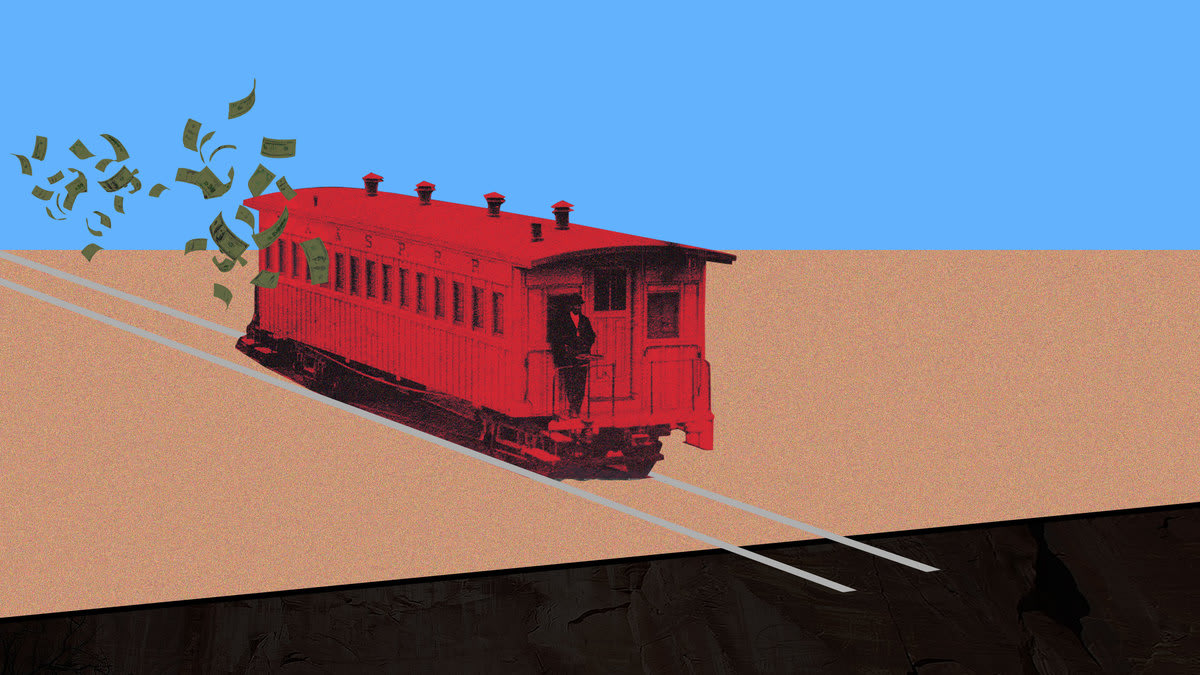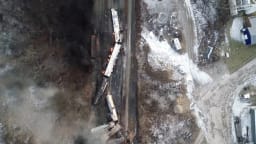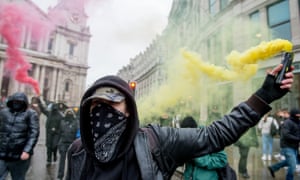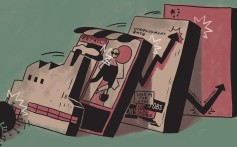An electric car fire is like 'a trick birthday candle' — and a nightmare for firefighters
Cyrus Farivar
It’s the kind of blaze that veteran Chief Palmer Buck of The Woodlands Township Fire Department in suburban Houston compared to “a trick birthday candle.”
On April 17, when firefighters responded to a 911 call at around 9:30 p.m., they came upon a Tesla Model S that had crashed, killing two people, and was now on fire.
They extinguished it, but then a small flare shot out of the bottom of the charred hulk. Firefighters quickly put out those flames. Not long after, the car reignited for a third time.
“What the heck? How do we make this stop?’” Buck asked his team. They quickly consulted Tesla’s first responder guide and realized that it would take far more personnel and water than they could have imagined. Eight firefighters ultimately spent seven hours putting out the fire. They also used up 28,000 gallons of water — an amount the department normally uses in a month. That same volume of water serves an average American home for nearly two years.
By comparison, a typical fire involving an internal combustion car can often be quickly put out with approximately 300 gallons of water, well within the capacity of a single fire engine.
As the popularity of electric vehicles grows, firefighters nationwide are realizing that they are not fully equipped to deal with them. So they have been banding together, largely informally, to share information to help one another out. In fact, Buck recently spoke on Zoom about the incident before a group of Colorado firefighters.
That’s because the way that electric vehicles are powered triggers longer-burning fires when they crash and get into serious accidents. Electric cars rely on a bank of lithium-ion batteries, similar to batteries found in a cellphone or computer. But unlike a small phone battery, the large batteries found in the Tesla Model X, for instance, contain enough energy to power an average American home for more than two days.
So when an electric vehicle gets in a high-speed accident and catches on fire, damaged energy cells cause temperatures to rise out of control, and the resulting blaze can require a significant amount of water to put out. Such vehicles, given their large electrical energy storage capacity, can be a considerable hazard, known as “stranded energy,” to first responders.
But training to put out these fires can’t come fast enough as more electric vehicles arrive on U.S. roads every day. According to IHS Insight, an industry analysis firm, the number of registered electric vehicles reached a record market share in the United States of 1.8 percent and is forecast to double to 3.5 percent by the end of this year. But IHS notes that 1 in 10 cars are expected to be electric by 2025.
Still, most firefighters across America have not been adequately trained in the key differences between putting fires out in gas and electric cars. Some counterparts in Europe have developed a different approach, sometimes even putting a burning electric vehicle into a converted shipping container or dumpster -- essentially giving it a bath -- so that it cannot do further harm. Tesla says in its publicly available first responders guide that this method is not advisable and that departments should just use lots of water to put fires out.
The problem has become widespread enough that late last year the National Transportation Safety Board published a report noting the “inadequacy” of all car manufacturers’ first responder guides. The agency further noted that while there are electric disconnection mechanisms, known as “cut loops,” they are often damaged in serious crashes. Finally, the NTSB also said that first responders generally lack an understanding of how to put out fires that can result from such crashes.
“The instructions in most manufacturers’ emergency response guides for fighting high-voltage lithium-ion battery fires lack necessary, vehicle-specific details on suppressing the fires,” the NTSB said
But there’s little that the board can do to fix the problem.
“We do not have any regulatory power, we do not have any enforcement power,” said NTSB spokesperson Eric Weiss, pointing out that such authority sits with the National Highway Traffic Safety Administration, or NHTSA.
In an email, Lucia Sanchez, a spokesperson for the safety administration, said that this topic remains important for the agency, one that it is “actively engaged in with our stakeholders including members of the first responder community.” In recent correspondence with the NTSB, the regulatory agency said that it continues to conduct research on “developing practical strategies for responders.”
Tesla, the largest electric-vehicle seller in the United States, did not respond to requests for comment about the NTSB report. But Capt. Cory Wilson, a 14-year veteran of the fire department in Fremont, California, where all U.S.-made Teslas are manufactured, said that Tesla has worked directly with his department for the past eight years. Still the best advice that Wilson gave was to advise firefighters to print out and keep Tesla safety guides in their trucks.
“Tesla has done a good job trying to get first responders educated,” he said.
Benedikt Griffig, a Volkswagen spokesperson, said in an email that German firefighting authorities have largely reached the same conclusion as their American counterparts, noting that they, too, may need considerable volumes of water to put out such a fire. Nissan spokesperson Ashli Bobo declined to respond to questions, but pointed to the company’s publicly available first responder guide. David McAlpine, a General Motors spokesman, said the company has actively worked on providing guidance for first responders working with electric vehicles and that "General Motors is committed to developing products that are safe and enjoyable for all our customers." Ford did not respond to requests for comment.
Recent discovery
While the first Tesla vehicles hit American streets in 2008, the National Transportation Safety Board did not investigate its first electric-vehicle battery fires until after an Aug. 25, 2017, crash of a Tesla Model X. That car was driving an estimated 70 mph or more down a residential street in Lake Forest, California, about an hour’s drive southeast of downtown Los Angeles.
According to the NTSB, the driver lost control of the car, crossed a sidewalk, traveled down a drainage ditch, hit a culvert and a property wall, and finally zoomed into an open garage and collided with a parked BMW, narrowly missing a man inside.
The Tesla caught fire, which spread to the BMW, then the garage and the house itself.
While Orange County Fire Authority’s firefighters put out most of the fire within 20 minutes, they found that a fire continued to burn in the attic above the fire, fueled by the burning Tesla. It took another 30 minutes for them to get the Tesla out of the garage, after which it reignited.
But 45 minutes after the flames on the Tesla were extinguished, it reignited again. Firefighters began hosing it down with copious amounts of water, up to 200 gallons per minute, but “that did not extinguish the flames,” according to the NTSB. At approximately 9:13 p.m., nearly three hours after the first alarm was received, firefighters had to pour out more than 600 gallons of water per minute. In the end, two firefighters sustained minor smoke inhalation-related injuries, and the agency used 20,000 gallons of water.
Capt. Sean Doran, the spokesperson for the Orange County Fire Authority, said that electric vehicle-related fires are a “game changer,” given that they require such huge amounts of water, and incidents can last hours longer than what most departments may be used to.
“One of the concepts in firefighting is don’t start what you can’t finish,” he said. “We don’t want to start applying water before we have a water source.”
It’s also often difficult for firefighters to get that volume of water outside of a mid-size city with adequate hydrants or other natural sources. That’s also what The Woodlands Township Fire Department, which responded to the Tesla crash in April, concluded.
“On a highway, to figure out how you’re going to get 20,000 gallons is a planning and logistics nightmare,” Buck, the fire chief, said.
Seeking help
Fire department officials say one of the biggest problems they face is that Tesla and other major car manufacturers often don’t include enough detail in their model guides for first responders as some fire agencies would like.On May 8, 2018, a 2014 Tesla Model S took a curve at 116 mph in a 30-mph zone in Fort Lauderdale, Florida. The car hit a wall in a residential area before it erupted in flames, then continued down the road and hit a light pole, finally stopping in a driveway. The driver and front passenger were both killed, while the rear passenger was seriously injured.
Fort Lauderdale Fire Rescue arrived four minutes after a 911 call was placed and began hosing down the car.
According to Asst. Fire Marshal Stephen Gollan, his agency had “minimal training” before this incident, but he knew enough to consult the Tesla online emergency response guide, which describes the “cut loops” that shut down the high voltage system. But firefighters couldn’t reach the loops.
The instructions for this model also includes the warning: “use large amounts of water to cool the battery. DO NOT extinguish fire with a small amount of water,” according to Tesla.
But Gollan said that not only does Tesla's manual lack a definition of “large amounts” of water, it also provides little detail about what firefighters should do with the remaining damaged batteries that may still contain dangerous stranded energy. In the end, Fort Lauderdale Fire Rescue used a combination of water and firefighting foam, even though Tesla does not recommend using foam.
“The Tesla manuals only say to use copious amounts of water,” he said. “They don't provide any direction as to how to remove that energy.”
In the end, the Tesla was loaded onto a tow truck for removal from the crash site. But the battery reignited twice during that process.
Like Buck in The Woodlands case, Gollan found himself quickly fielding calls from numerous agencies trying to learn more about how to put out electrical vehicle fires from someone who had done it firsthand.
“Following the incident we did substantial debriefings with NTSB and other municipal fire departments,” he said. “And since that time I've had multiple calls with other agencies from across the U.S.”
Support groups
While some firefighters are now turning to one another for help, like Buck speaking to his counterparts in Colorado, other groups like the National Fire Protection Association (NFPA), a lobbying and research arm for the fire insurance and firefighting community, are also trying to address the growing demand for their firefighter courses.
While the NFPA has trained approximately 250,000 firefighters and emergency responders in the last 12 years on this issue, that leaves nearly 80 percent of the more than 1.1 million firefighters nationwide left to train, according to the organization. Of those, approximately two-thirds are volunteers and may be harder to reach.
“With EVs (electric vehicles), especially for the fire service, it’s a new paradigm,” said Andrew Klock, the group’s emerging issues lead manager.
Robert Swaim, who retired nearly two years ago, spent more than 30 years at the NTSB. He began digging into the issue with lithium-ion batteries after a Boeing 787 caught fire in Boston in 2013.
Swaim has been offering his own training, comparable to ones offered by NFPA, except his classes are live -- and he brings his own Chevy Volt to class. He points out that his in-person and hands-on training is considerably more helpful than the myriad of PDFs that various manufacturers put out. He said that after recently posting some of his presentation slides, traffic to his website has jumped by more than a factor of 10.
“You’re going to tell me that a volunteer firefighter is going to go to the Ford website and learn about Ford’s emergency response guide?” he said. “That’s not going to happen.”
Continuing problems
In the meantime, fire departments are facing far more time-intensive fires. In the past, most car fires were put out in well under an hour. Then the scene was turned over to local law enforcement, and a tow company moved the car.
“Then we are going to have to sit on scene usually for 45 minutes to an hour with our [thermal imaging camera] to make sure the battery is not continuing to heat up,” said Wilson, the Fremont Fire captain.
Later this summer, Buck is set to give another presentation to his former agency, the Austin Fire Department, where he worked for 27 years. The Texas capital is set to become Tesla’s new manufacturing hub, known as Gigafactory Texas, where the company’s new all-electric Cybertruck is expected to be produced.
Buck fears that as electric cars become larger, they’re going to need bigger batteries, which could mean even longer-burning fires. He notes that this is too big a burden on small fire departments.
“The time on scene is more concerning than even the amount of water — the fact that I might have a unit tied up for multiple hours while it cools down,” he said. “I'm just babysitting, and that’s problematic.”


















